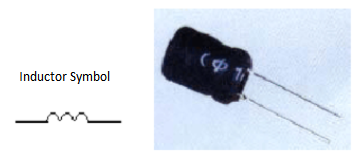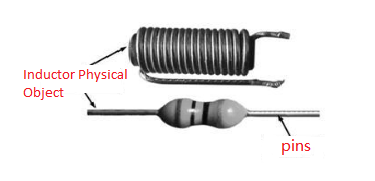What is inductor
An inductor is a component that converts electrical energy into magnetic energy by creating a magnetic field in a conductor. The basic structure of an inductor is a winding around a magnetic material that generates a magnetic field when energized, and the strength of the magnetic field depends on the size of the current. When the current changes, the magnetic field changes with it, creating an electromotive force inside the inductor. This electromotive force can counteract the current, thus controlling the current and signal in the circuit. Therefore, inductors are often used to control the current, frequency, phase difference and gain in the circuit.
Inductor Symbol
In the circuit schematic diagram, the inductor is commonly represented by the symbol "L" or "T", and the figure below is the graphic symbol of the ordinary inductor in the electronic circuit diagram, also known as the circuit symbol. It can be seen that it is mainly composed of several semicircular thick lines and two lead lines, several semicircular thick lines are the graphic symbol of the inductor (equivalent to the simplified outline of the inductor coil), the two leads are equivalent to the two pins of the inductor, extended from both ends of the graphic symbol, and the electrical route in the circuit diagram is connected to form an electronic circuit.


Inductor Characteristics
1 Self-induction: An important characteristic of the inductor is its self-induction, that is, the electromotive force generated by the presence of a magnetic field inside the coil. The magnitude of self-inductance is related to the winding mode of the coil, the length of the coil, and the strength of the magnetic field in the coil. The existence of self-inductance enables the inductor to stabilize and restrain the change of current in the circuit.
2 Impedance: An inductor is a component that has an impedance. Impedance refers to the degree of resistance of the inductor to the alternating current, and is represented by the symbol Z. The impedance depends on the inductor's self-inductance and current frequency. When the frequency is low, the influence of self-inductance on current is more significant, and the impedance of inductor is larger. When the frequency is higher, the impedance of the inductor is smaller.
3 Energy storage: The inductor can convert electrical energy into magnetic energy for storage and re-release it at the appropriate time. This ability of energy storage and release makes inductors widely used in circuit filtering, energy storage and so on.
Inductor functions
The inductor is characterized by passing DC and blocking AC. That is, direct current can pass through the inductor without hindrance, while alternating current will receive great resistance when passing. The main functions of inductors are high-frequency choke, filtering and resonance.
RELATED: DC Voltage: What is It & DC VS AC Symbols
Applications of Inductors
Inductors are essential components in various electrical and electronic circuits, and they find applications in a wide range of devices and systems. Some common applications of inductors include:
1. Filters: Inductors are used in conjunction with capacitors to create filters that can pass or block certain frequencies in signals. They are commonly found in audio equipment, communication systems, and power supplies.
2. Transformers: Inductors are key components in transformers, which are used to step up or step down voltages in electrical systems. Transformers are crucial in power distribution, electrical equipment, and electronic devices.
3. Oscillators: Inductors are used in oscillator circuits to generate and control oscillations at specific frequencies. They are used in radio frequency circuits, signal generators, and communication systems.
4. Power Supplies: Inductors play a role in power supply circuits for energy storage and filtering. They help smooth out the output voltage and reduce ripple in DC power supplies.
5. Electric Motors: Inductors are used in electric motors to control the speed and torque of the motor. They are found in various types of motors, including AC and brushless DC motors.
6. RF Circuits: Inductors are crucial components in radio frequency (RF) circuits for impedance matching, filtering, and tuning. They are used in antennas, transmitters, receivers, and RF amplifiers.
7. Sensors: Inductors can be utilized as sensing elements in proximity sensors, metal detectors, and inductive proximity switches due to their ability to detect changes in inductance caused by nearby objects.
8. Lighting Systems: Inductors are used in lighting ballasts to regulate the flow of current and provide the necessary voltage for fluorescent and HID (high-intensity discharge) lamps.
Overall, inductors play a vital role in a wide range of applications across industries such as electronics, telecommunications, power systems, automotive, and more, showcasing their versatility and importance in modern technology.
Inductor Types
(1) Classification by structure
Inductors can be divided into wire-wound inductors and non-wire-wound inductors (multilayer sheet, printed inductors, etc.) according to their different structures, and can also be divided into fixed inductors and adjustable inductors.
According to the mounting method: there are chip inductors, plug-in inductors. At the same time, the inductor has an external shield to become a shield inductor, and the exposed coil is generally called an unshielded inductor.
Fixed inductors are divided into hollow electronic sensing, magnetic core inductance, iron core inductance, etc. According to its structural shape and pin mode, it can also be divided into vertical lead inductance, horizontal axial lead inductance, large and medium-sized inductance, small and exquisite inductance and sheet inductance.
The adjustable inductance is divided into magnetic core adjustable inductance, copper core adjustable inductance, sliding contact adjustable inductance, series mutual inductance adjustable inductance and multi-tap adjustable inductance.
(2) Classification by working frequency
Inductors can be divided into high frequency inductors, medium frequency inductors and low frequency inductors according to the operating frequency. High frequency inductors have a large gap in technology, and many manufacturers' products are immature. Hollow inductors, magnetic inductors and copper inductors are generally medium or high frequency inductors, while iron inductors are mostly low frequency inductors.
(3) Classification by purpose
Inductors can be divided into oscillating inductors, correcting inductors, picture tube deflection inductors, choke inductors, filter inductors, isolation inductors, compensated inductors, and Jebison power inductors are used for situations where large currents are required.
The oscillating inductance is divided into the TV line oscillation coil, the east-west pillow correction coil and so on.
The picture tube deflection inductor is divided into line deflection coil and field deflection coil.
Choke inductance (also known as choke coil) is divided into high frequency choke coil, low frequency choke coil, electronic ballast choke coil, TV line frequency choke coil and TV field frequency choke coil.
Filter inductors are divided into power supply (power frequency) filter inductors and high frequency filter inductors.
RELATED: Properties of Impedance and Capacitance in a Capacitor




